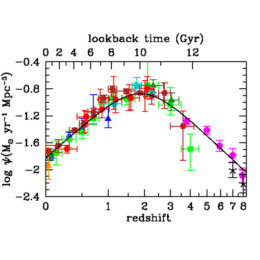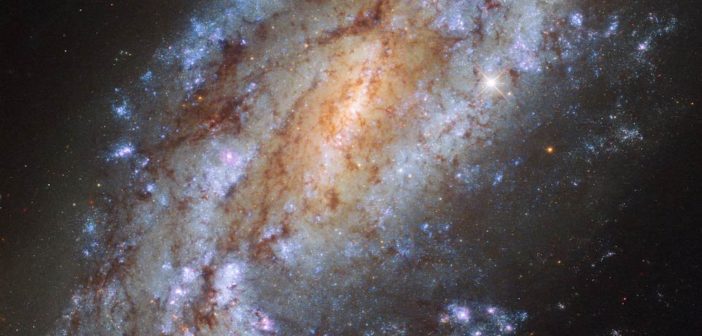Star formation in galaxies appears to be highly regulated by the flow of gas into and out of galaxies. We still haven’t pinned down the specifics of these flows, but we can learn a lot about them by studying galaxies during “cosmic noon”, when star formation rates across the universe were at their highest.

Star formation rates versus redshift (lower axis) and lookback time (upper axis). The star formation rates were determined from infrared and ultraviolet observations. The peak around redshifts 2 and 3, or “cosmic noon”, is evident. [Madau & Dickinson, 2014]
The Ins and Outs at Cosmic Noon
“Cosmic noon” corresponds to redshifts of z = 2–3, when the universe was roughly between 2 to 3 billion years old (coincidentally). Over this relatively short period, galaxies formed about half of their current stellar mass. This makes cosmic noon an ideal time to examine mechanisms of star formation.
Stars form from gas, and gas is constantly flowing in and out of galaxies. Specifically, gas flows between the intergalactic and the interstellar mediums, passing through the circumgalactic medium (CGM) as it does. So, the CGM is a record-keeper of what sort of gas has flowed in and out of a given galaxy.
Since stars convert lighter elements into heavier elements, we’d expect that the gas flowing into a galaxy is dominated by light elements while the gas flowing out contains more heavy elements. However, we haven’t observed this effect at low redshifts, likely due to several intervening factors like dust and gas mixing. But could it be more apparent at higher redshifts, like at cosmic noon?
A recent study led by Nikole Nielsen (Swinburne University of Technology/ARC Centre of Excellence for All Sky Astrophysics in 3 Dimensions, Australia) presents the first results from the “CGM at Cosmic Noon with Keck Cosmic Web Imager” program, which aims to study gas flows from galaxies during cosmic noon. Using data taken by the Keck Cosmic Web Imager (KCWI), the Hubble Space Telescope, and the Very Large Telescope, Nielsen and collaborators studied the properties of one particular galaxy at z ~ 2 in great detail.
Absorbing as Much Information as Possible

The Hubble Space Telescope’s view of the focus galaxy in this study (G) along with the quasar that lights up its absorber (QSO, or “quasi stellar object”). [Adapted from Nielsen et al. 2020]
We don’t take it for granted that an absorber is associated with a galaxy, which is where the KCWI and Hubble data come in. The KCWI data can be used to find the characteristic hydrogen emission from a galaxy, while the Hubble images allow for galaxy shape to be determined. The focus galaxy of this study appears edge-on to us, with the quasar shining down its narrower axis.

The left plot is the KCWI view of the quasar (QSO) and focus galaxy (G); the upper right plot is the Hubble image of the focus galaxy. The middle and lower right plots show the hydrogen emission from the galaxy and the absorption signature in the quasar spectrum respectively. Click to enlarge. [Nielsen et al. 2020]
Likely on Its Way Out
Based on features of our own galaxy and the focus galaxy’s likely orientation, Nielsen and collaborators assumed that the gas flows associated with magnesium are outflows. If this is the case, then the authors estimate that gas is flowing out of the galaxy at a rate of perhaps 50 solar masses per year. The CGM of the focus galaxy does appear to be more enriched with heavy elements than average, but not so enriched that it’s completely dominated by outflows.
Nielsen and collaborators noted that there are many viable interpretations of these data, so no absolute conclusions can be made based on this one galaxy. More detailed models that account for the effects of different elements and galaxy orientations will be useful in the future. However, this study is an excellent demonstration of what can be done by combining data from different instruments. So, on to the next galaxy!
Citation
“The CGM at Cosmic Noon with KCWI: Outflows from a Star-forming Galaxy at z = 2.071,” Nikole M. Nielsen et al 2020 ApJ 904 164. doi:10.3847/1538-4357/abc561

3 Comments
Pingback: From AAS NOVA : “Seeing Star Formation at Cosmic Noon” | sciencesprings
Pingback: Obserwowanie procesów gwiazdotwórczych w kosmiczne południe – PTMA Kraków
Pingback: Obserwowanie procesów gwiazdotwórczych w kosmiczne południe – Astronomia Śląska